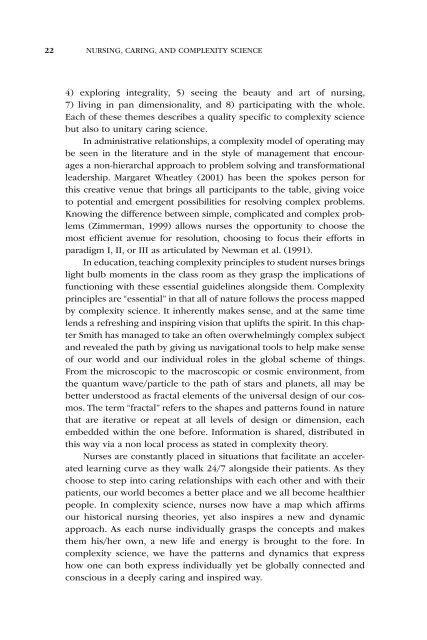Nursing, Caring, and Complexity Science: For Human ... - Axon
Nursing, Caring, and Complexity Science: For Human ... - Axon
Nursing, Caring, and Complexity Science: For Human ... - Axon
You also want an ePaper? Increase the reach of your titles
YUMPU automatically turns print PDFs into web optimized ePapers that Google loves.
22 NURSING, CARING, AND COMPLEXITY SCIENCE<br />
4) exploring integrality, 5) seeing the beauty <strong>and</strong> art of nursing,<br />
7) living in pan dimensionality, <strong>and</strong> 8) participating with the whole.<br />
Each of these themes describes a quality specific to complexity science<br />
but also to unitary caring science.<br />
In administrative relationships, a complexity model of operating may<br />
be seen in the literature <strong>and</strong> in the style of management that encourages<br />
a non-hierarchal approach to problem solving <strong>and</strong> transformational<br />
leadership. Margaret Wheatley (2001) has been the spokes person for<br />
this creative venue that brings all participants to the table, giving voice<br />
to potential <strong>and</strong> emergent possibilities for resolving complex problems.<br />
Knowing the difference between simple, complicated <strong>and</strong> complex problems<br />
(Zimmerman, 1999) allows nurses the opportunity to choose the<br />
most efficient avenue for resolution, choosing to focus their efforts in<br />
paradigm I, II, or III as articulated by Newman et al. (1991).<br />
In education, teaching complexity principles to student nurses brings<br />
light bulb moments in the class room as they grasp the implications of<br />
functioning with these essential guidelines alongside them. <strong>Complexity</strong><br />
principles are “essential” in that all of nature follows the process mapped<br />
by complexity science. It inherently makes sense, <strong>and</strong> at the same time<br />
lends a refreshing <strong>and</strong> inspiring vision that uplifts the spirit. In this chapter<br />
Smith has managed to take an often overwhelmingly complex subject<br />
<strong>and</strong> revealed the path by giving us navigational tools to help make sense<br />
of our world <strong>and</strong> our individual roles in the global scheme of things.<br />
From the microscopic to the macroscopic or cosmic environment, from<br />
the quantum wave/particle to the path of stars <strong>and</strong> planets, all may be<br />
better understood as fractal elements of the universal design of our cosmos.<br />
The term “fractal” refers to the shapes <strong>and</strong> patterns found in nature<br />
that are iterative or repeat at all levels of design or dimension, each<br />
embedded within the one before. Information is shared, distributed in<br />
this way via a non local process as stated in complexity theory.<br />
Nurses are constantly placed in situations that facilitate an accelerated<br />
learning curve as they walk 24/7 alongside their patients. As they<br />
choose to step into caring relationships with each other <strong>and</strong> with their<br />
patients, our world becomes a better place <strong>and</strong> we all become healthier<br />
people. In complexity science, nurses now have a map which affirms<br />
our historical nursing theories, yet also inspires a new <strong>and</strong> dynamic<br />
approach. As each nurse individually grasps the concepts <strong>and</strong> makes<br />
them his/her own, a new life <strong>and</strong> energy is brought to the fore. In<br />
complexity science, we have the patterns <strong>and</strong> dynamics that express<br />
how one can both express individually yet be globally connected <strong>and</strong><br />
conscious in a deeply caring <strong>and</strong> inspired way.
















